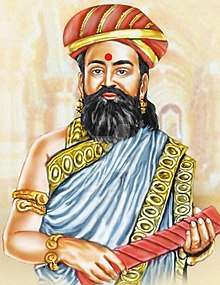Kambar (poet)

Kambar (Kamban in casual address) (c. 1180, Therazhundur, Nagapattinam district, India – 1250)[1] was a medieval Tamil Hindu poet and the author of the Ramavataram, popularly known as Kambaramayanam, the Tamil version of the epic Ramayana.[2] Kambar also authored other literary works in Tamil, such as 'Thirukkai Vazakkam', Erezhupathu, Silaiezhupathu, Kangai Puranam, Sadagopar Anthathi, and Saraswati Anthathi.[2]
Life
[3] Kambar was brought up in the household of a wealthy farmer named Sadaiyepa Vallal in Vennai Nellur in Tamil Nadu. The Chola king—having heard of this talented bard—summoned him to his court and honoured him with the title Kavi Chakravarty (The Emperor of Poets).[2]
Kamban flourished in Therazhundur, a village in the culturally rich Nagapattinam District in the modern state of Tamil Nadu in South India. Kamban was a great scholar of both Sanskrit and Tamil - two of India's oldest and richest languages in terms of literary works. In a scholarly biography, Kavichakravarty Kamban, Mahavidwan R. Raghava Iyengar wrote in detail about this 12th-century poet.
Literary works
- Kamba Ramayanam (also called Ramavataram) - Retelling of the Indian epic Ramayana in Tamil. Work covers 11,000 stanzas.
- Saraswati Anthati - Literary work of style Andhadhi in praise of Hindu Goddess Saraswati
- Sadagopar Anthathi - Literary work of style Andhadhi in praise of Vaishnava Saint Nammalvar
- Silaiezhupathu - Work in praise of 11th century Pallava king Karunakara Tondaiman
- Thirukkai Vazakkam
- Erezhupathu
- Kangai Puranam
Kamba Ramayanam

The original version of Ramayana was written by Valmiki. It is an epic of 24,000 verses which depicts the journey of Rama, a prince of Ayodhya who belonged to Raghuvamsa (Solar dynasty). In Hinduism, Rama is the seventh incarnation of Lord Vishnu, one of the Trimurti (the Hindu holy trinity which includes Brahma and Shiva).
The Ramavataram or Kamba Ramayanam of Kamban is an epic of about 11,000 stanzas, as opposed to Valmiki's 24000 couplets.[4][5] The Rama-avataram or Rama-kathai as it was originally called was accepted into the holy precincts in the presence of Vaishnava Acharya Naathamuni.[6]
Kamba Ramayana is not a verbal translation of the Sanskrit epic by Valmiki, but a retelling of the story of Lord Rama.[6]
Legend has it that the entire episode was written in one night by Lord Ganesh. Ganesha is said to have written the poems that Kambar dictated to him during the night, as Kambar procrastinated the work till the day before the deadline set by the King.
There is also a legend that Ottakuthar—an eminent Tamil poet and a contemporary of Kambar[7][8]—also composed Ramayanam. Tradition has it that Ottakoothar was ahead of Kambar as the former had already finished five cantos, but when the king asked for an update, Kambar—a master of words—lied that he was already working on the Setu Bandhalam, upon which Ottakoothar was dejected and threw away all his work. Feeling guilty, Kambar recovered the last two chapters of Ottakoothar's composition and added these into his own.[9]
Kamba Ramayana was first delivered in Sri Ranganathaswamy Temple, Srirangam at the court hall (Kambar Arangetra Mandapam) near Thaayar sannithi.
Legend says that when contemporaries objected to Hiranyavadaipadalam ("Story of Hiranyakasipu", which occurs as Vibhishana telling Ravana while warning against his false sense of invincibility), Kamban read it in front of the Narasimha Swami temple in Sri Ranganathaswamy Temple. The Swami applauded by laughing out aloud from his Sanctum Sanctora (Mettu Narasimhar Sannidhi), and this was taken as proof of approval.
Kambar's praise
_2Feb2013.jpg)
Many Tamil poets, statesmen, kings, and common people have praised Kambar for his Kambaramayanam, which has more than 10,000 songs and 45,000 lines, forming one of the greatest of Tamil epics.
A common word of praise attributed to Kambar is that even the mill in his house would sing ("Kambar veettuk kattuththariyum kavipadum"; "கம்பர் வீட்டுக் கட்டுத்தறியும் கவி பாடும்"). He is considered special in singing poems under "Viruthapa".
"Kamba Sutram" (கம்ப சூத்திரம்) is a phrase used by Tamil people in their day-to-day activity. It was originally "Kamba Chithiram", denoting Kamban's art. However, over a period of time, it came to be rendered as "Kamba Sutram". The phrase is used just like "rocket science", which clearly denotes that skills of Kambar in writing poem with viruthapa is as difficult as "rocket science".
Notes
| Wikimedia Commons has media related to Kambar (poet). |
- ↑ "Kampan." Encyclopædia Britannica. Encyclopædia Britannica Online. Encyclopædia Britannica Inc., 2011. Web. 23 December 2011.
- 1 2 3 The Cyclopaedia of India and of Eastern and Southern Asia By Edward Balfour
- ↑ India's Communities by Kumar Suresh Singh, Anthropological Survey of India – Ethnology – 1992 – 4146 pages
- ↑ Legend of Ram By Sanujit Ghose
- ↑ Gopal, Madan (1990). K.S. Gautam, ed. India through the ages. Publication Division, Ministry of Information and Broadcasting, Government of India. p. 212.
- 1 2 Rays and Ways of Indian Culture By D. P. Dubey
- ↑ Biographical vistas: sketches of some eminent Indians, page 52
- ↑ The Tamils and their culture, page 82
- ↑ Tamil Literature, page 220
Template:Hindu Scriptures
.jpg)